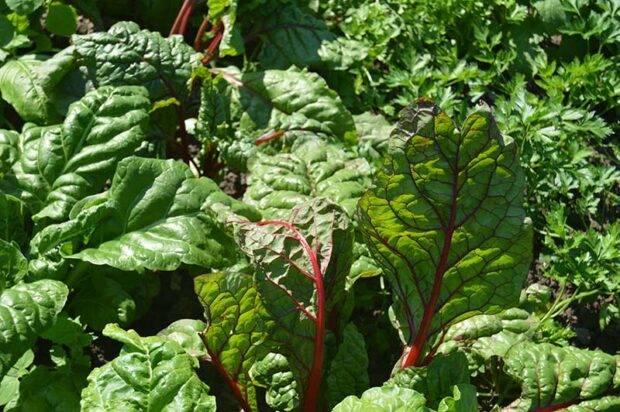
What do leaf lettuces, kale, Swiss chard, spinach, broccoli, and cabbage have in common? They are all examples of “cut and come again” vegetables. What exactly do we mean by that? Well, as the name implies, it is a vegetable that can have edible portions cut off, but will continue to grow and produce more portions that can be cut again at a later time. Usually, leafy vegetables that grow as a rosette (in a circular fashion or from a central point) are most likely to be cut and come again. Rosette-type plants include: broccoli, Brussels sprouts, cabbage, kale, leaf lettuces, spinach and Swiss chard, among a few others.
Many gardeners are probably familiar with cutting just the outer leaves of kale, spinachand leaf lettuce, so that the plant continues to produce fresh leaves that can be cut again a few days or weeks later. This helps extend the harvest without adding more plants to the garden. Eventually the plant will bolt (go to seed), at which point the vegetable will no longer produce the sweet edible leaves you want to cut, and the plant will need to be removed. It is also possible to cut the entire head of leaf lettuce providing the cutting is done about 1-1/2 inches above the crown, the growing point of the plant. If you cut off the crown, you may as well remove the whole plant.
Swiss chard and beet leaves also grow as a rosette. By harvesting just the outer stalks of the chard, it will continue to send up new shoots for later cutting. If you like to eat the greens on a beet, then you can harvest a couple of the outer leaves from each plant. When you cut the outer greens, leave about an inch or so of the stem on the beet.
While broccoli, Brussels sprouts and cabbage are also rosette plants, we don’t think of them the same way as most of the loose, leafy plants. Probably because we are harvesting the flower head of broccoli, the large head of the cabbage, and the small buds of the Brussels sprouts. However, done correctly, these vegetables will also continue to produce more for harvesting.
For Brussels sprouts, harvest from the bottom up. Cut the larger heads that develop at the bottom and allow the buds higher up to continue developing, then harvest as they grow. If you cut the rosette tip of the plant, the sprouts will tend to mature at the same time. For broccoli, if you cut the terminal head, side shoots will develop. They will not be as large as the main head, but will continue to be produced for several weeks. Lastly, for cabbage, cut the large central head, leaving the outer leaves and the root in the ground. Wait a few weeks and you should begin to see smaller heads forming at the base of the leaves that were left. These will grow into small cabbage heads, just a few inches in diameter, but sweet and delicious in soups, stews or salads.
Think of “cut and come again” as a type of plant pruning. As with all pruning, be sure that your cutting tool is clean and sharp. Take care not to cut the growing crown. Cut the mature outer leaves, preferably while they are still a little young, to help maintain the quality of the successive cuttings. Use care to maintain watering to reduce stress on the plant. Eventually all good things come to an end, so when the cuttings begin to lose flavor, the plant loses vigor, or seed formation (bolting) begins, the harvest is over and it’s time to grow something new!
Mary Gerstenberger was the Consumer Horticulture Coordinator at the Michigan State University Extension in Macomb County, MI. For vegetable and gardening information from MSU, visit www.migarden.msu.edu.
Call the toll-free Michigan State University Lawn and Garden Hotline at 888-678-3464 for answers to your gardening questions.

